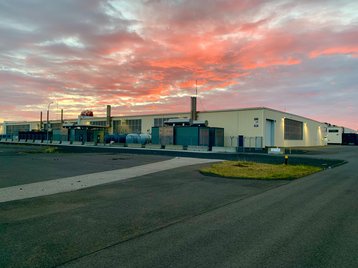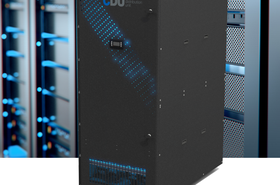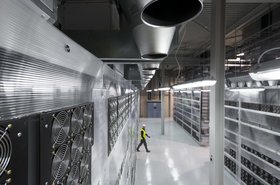When Verne Global started on its flagship Icelandic project, there wasn’t much in the way of a data center industry on the remote island.
Verne’s goal was to take disused NATO buildings on a naval air station by Iceland’s Keflavik international airport, and turn them into colocation space. That required some hard work.
Data centers need data, so Verne needed new submarine cables to the Nordic nation. Then Verne had to negotiate tax rates for the nascent industry, and finally set about training up the workforce.
The project was first announced in February 2008, was almost immediately hit by setbacks: A 6.1-Richter scale earthquake in June, and then the impact of the global financial crisis that disproportionately damaged the local economy, caused investors to tighten purse strings, and led to currency restrictions.
A year after signing an MoU to turn the Naval Air Station into a high-performance computing data center, the whole effort was delayed by another year. Later on, Iceland suffered the 2011 volcanic cloud which restricted travel, and changes in the industry led to Verne pivoting to focus more specifically on high performance computing (HPC) in around 2012.
This feature first appeared in the 2020 modernization supplement. Read it for free today.
Laying the groundwork
But back at the beginning, 2008 was also the year that Tate Cantrell joined the company, undeterred by the inauspicious start. “There was definitely an opportunity in Iceland [for data centers], but in order to make it successful, we really had to build up an industry - and that's that's actually where I got involved,” he told DCD.
“I was out building big data centers around the world,” the former VP at DuPont Fabros said. “And Verne really wanted to tackle a wholesale approach to data center construction in Iceland.”
Acquiring a former NATO base has its advantages, most notably the pre-built high security features. But taking over any existing infrastructure brings with it unique challenges.
“One of the things I learned in my previous job and as I looked at a 40-acre campus and did greenfield design was that I always tried to avoid squares,” Cantrell said. “I like rectangles.”
That’s more than an aesthetic choice. Data centers have to operate with a flow of energy converted from electricity to heat, explained Cantrell: “If you put your electricity on one side and your cooling on the other, it helps from a logistical standpoint during construction. It makes for typically pretty nice site arrangements.”
In Iceland, Cantrell says with a laugh, he was given squares: “three 60 meter by 60 meter squares separated by half a meter of concrete.
"In one regard, I got a bit of an ugly child to help grow up.”
The company first converted buildings 868 and 869, which the Official Journal of the European Union lists as 'NATO warehouse/supply building' and 'Navy Exchange warehouse,' respectively. Or, as Cantrell calls them: "Brick shithouses."
The buildings weren’t too much of a challenge in the early days. At this stage, Verne simply used modular designs, building a shell within a shell. Its first two modules were built using a pre-fabricated data center design from Colt which was shipped from a factory site in the UK. They opened in 2011 and 2013.
“We were slotting in these pre-configured buildings and, and the existing structures were nice because it was a demarcation point,” Cantrell said. “We had local power expertise, so we did all the substations and power infrastructure set up, we did the offices, and then we were ready to just slide those modular components into place.”
The modular work also allowed the local operators to gain specific knowledge about the industry, allowing the company in 2013 to shift to designing and building in house, at a lower cost. That meant dealing with those squares.
“What we did was take a rectangular design and fold it in on itself,” Cantrell said. “We ended up with a center plane of infrastructure that was both mechanical and cooling and then have the data centers out on the wings. The most rewarding phase was working with the local teams to take the knowledge that we gained working with the modular components and bringing that into our own designs.”
Since 2013, the company has shifted its emphasis further towards high performance computing (HPC), eventually launching an HPC-as-a-service offering, HPCdirect.
The buildings had been designed to store heavy military equipment, so they have “super resilient slab floors, we haven't had to do any upgrades of that,” Cantrell said. “As we’re HPC, we want people to feel very comfortable with putting water-cooled, two-ton equipment sitting in the space of a rack.”
With the cold climate, Verne primarily uses ambient cooling, but turns to liquid for some more demanding HPC customers. Usually, outside temperatures are comfortably below what’s needed to keep the servers cool, but in the rare summer days where temperatures reach up to 19°C (66.2°F), Cantrell claims that the thick concrete walls are an advantage. “It’s cold all night, and the thermal mass of the buildings actually helps you kind of ride through those higher temperature zones.”
The buildings required some upgrades to make them suitable for data center use, of course. Notably, the loading dock needed to be modernized, with the US-based design team initially planning to put in standard data center loading docks. “They were visiting Iceland to go fishing and engineering it remotely and using the local Icelandic engineers as effectively draftsmen with a stamp,” Cantrell said. “I identified pretty quickly that that was going to turn into a train wreck.”
The problem is that Iceland’s loading docks aren’t the same as those in Virginia. First there’s the fact that nearly everything comes to the country via container, and at the harbor they don’t bother unloading the goods onto a lorry - they just use trucks to carry the container. Another common shipping method is the Icelandic vehicle ‘Sendibill,’ which is “essentially a box truck.”
Then there’s the cold - during the winter a container could easily freeze if left out too long. Plus the company still gets the occasional lorry truck.
“So we came up with a concept where we could receive four types of shipments,” Cantrell said. “And we created this plinth that's heated with geothermal water for the winter.” Iceland has a plentiful supply of warm water: it’s a byproduct of the geothermal electricity supply.
Ask those that know
This modernization innovation came about because of a close collaboration between the data center experts and those that understood the local environment, Cantrell argues. “We're doing some commissioning right now for a data center project and the local engineering team is sending extra people at their cost just to kind of get their hands dirty and touch and see what goes into these data centers,” he said. “We think that's really positive for the industry at large.”
He also believes that it’s preferable to reuse existing building structures - like those NATO hangars - where possible: “We were able to reduce our costs, we were able to double down on the green aspect of our campuses, we were able to leverage some existing infrastructure and take advantage of it.”
In his time working with the wider data center industry, Cantrell often found himself surrounded by “people who aren't creative that immediately just come to the conclusion ‘Oh, we just have to knock the building down, because it's more expensive.’ And I challenge that I think that's probably lazy engineering, to be honest with you.”
He admits that there are challenges - “you certainly walk into your design with limitations” - and that requires you to be more creative “because if you just turn the buildings into Swiss cheese, well then they weren't really much use for you and you might end up spending more money,” but believes that the extra effort can be worth it.
“All you have to do is is walk through an old Italian city and you can see the mentality of ‘let's work with what we've got and continue to improve it,’” Cantrell said. “With [our data centers], there are some nice bespoke features that we were able to put in because we did have to come to the process with a creative line.”
There are times when it's not possible to do an adequate conversion, of course. Back in 2004, Cantrell looked at chip fabs as potential data center sites, "and that was a challenge for me because you've got all this beautiful infrastructure, but it just didn't match the form factor of what we wanted to accomplish on the data center side.
"Sometimes you're going to walk into an industrial facility, and it's just not going to work out," he said. "But you need to think about it first."
Back in Iceland, the company is thinking about what to do next with its third and final ‘brick shithouse.’ Fresh off a $27m fund raise, with another in the pipeline, Verne has expansion on the mind.
“We’re going to be using this last cube of space as what I would call a transitional project to building a more bespoke project,” Cantrell said. After that, things are going to come full circle, “some very modular things in mind.”
It also means the company will have to design one crucial aspect of a newbuild construction: “I guess we have to do walls this time.”






